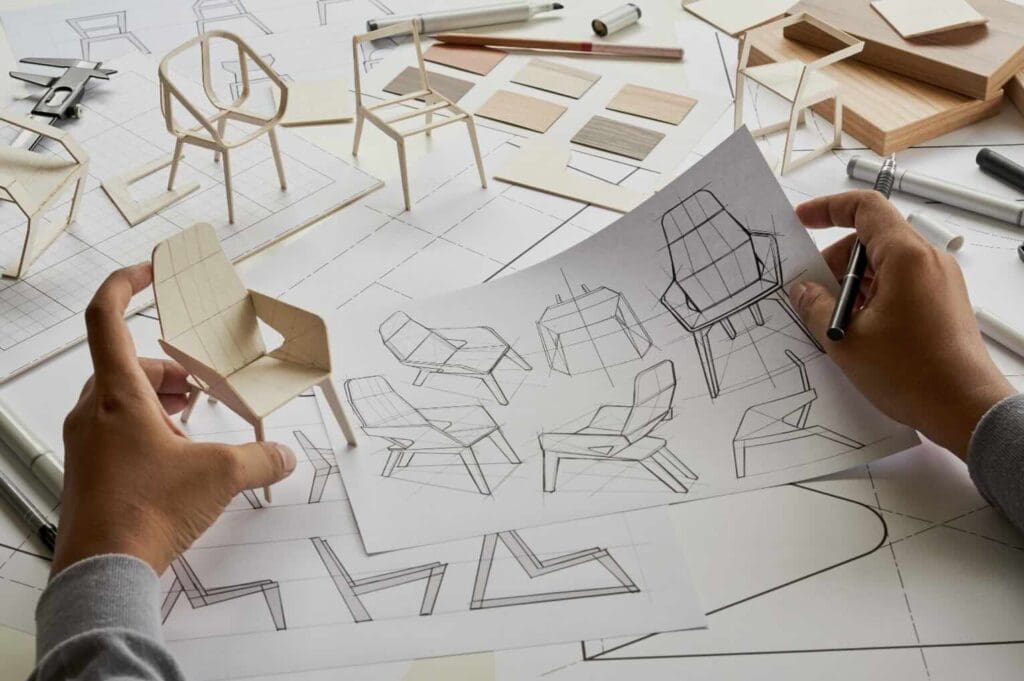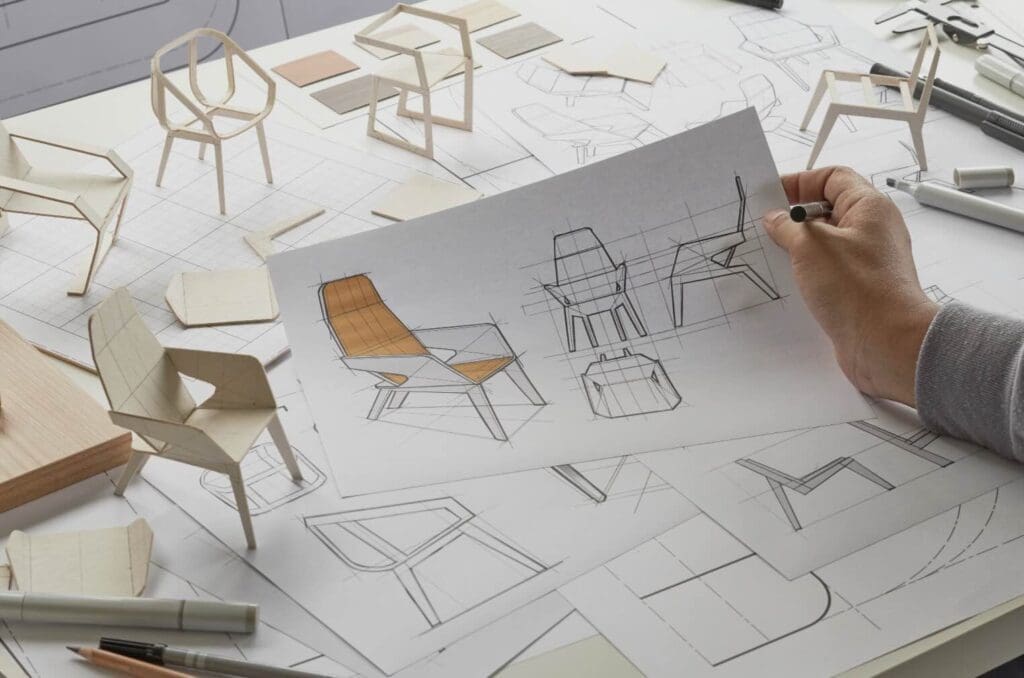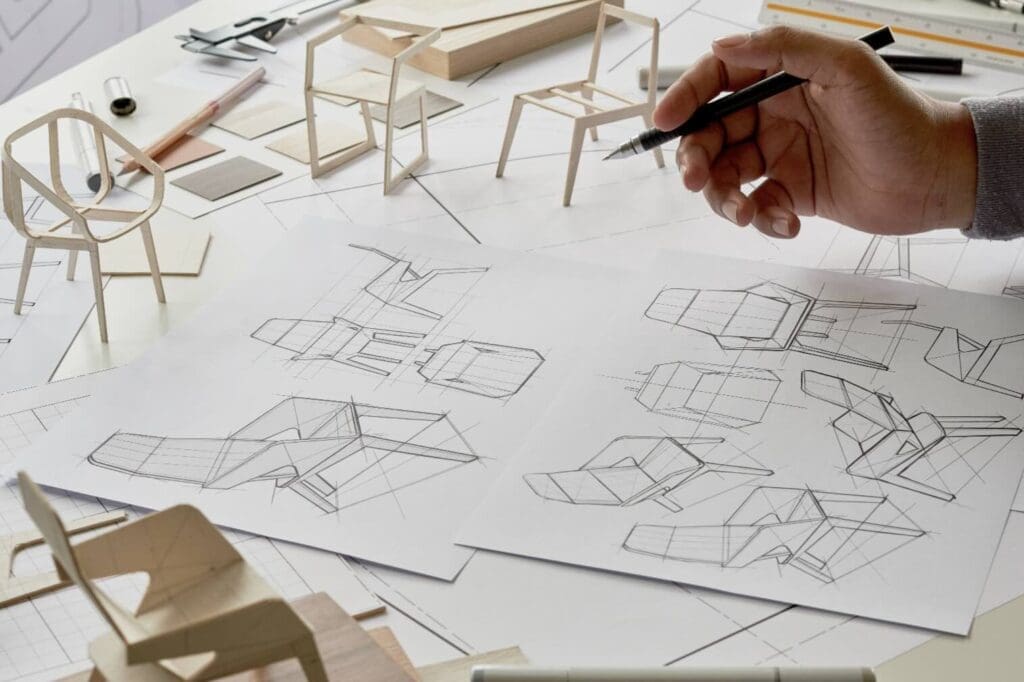Harmonizing form and functionality, modern furniture design represents a unique blend of art and practicality. With changing times and evolving needs and preferences, the design landscape has continually transformed, taking on new shapes and molds.
One can trace the influence of socio-cultural tendencies, technological revolutions, environmental consciousness, and customer preferences upon this progression. This discussion delves into the multidimensional plane of modern furniture design, focusing on evolution, technological impact, sustainability, and the customer-centric approach.
Table of Contents
- The Evolution of Modern Furniture Design
- The Impact of Technology on Furniture Design
- Sustainability and Eco-Friendliness in Furniture Design
- Customer-Centric Approach in Furniture Design
- Related Content
The Evolution of Modern Furniture Design
The Evolution of Modern Furniture Design: A Journey of Innovation
The furniture world has been a canvas for artisans and creators, transforming and adapting over time into stunning showcases of technological advancement, innovative design, and societal trends. One cannot speak of this evolution without looking at modern design’s role in paving this journey to beautiful functionality.
Originally born out of the Bauhaus movement in the 1930s, modern furniture design strived to merge form with function, shedding unnecessary decorative elements and focusing on minimalist aesthetic guidelines.
This was a paradigm shift from the heavily opulent styles of previous eras, daringly focusing on functionality and form above all else. For instance, Marcel Breuer’s Wassily Chair took design cues from bicycle handlebars, providing a stark, surprising contrast yet setting the stage for a relentless pursuit of streamlined design.
Post World War II, design ethos leaped forward, and as the economy soared, the concept of ‘mid-century modern’ emerged. The era brought a fluid mix of organic shapes, clean lines, and diverse materials – primarily molded plywood, plastic, and steel. Names such as Eero Saarinen and Charles and Ray Eames rose to prominence due to their revolutionary pieces that combined comfort, aesthetics, and affordability – the doctrine of the mid-century movement.
With the 70s and 80s came a bold departure from strict minimalism with the rise of postmodernism. Memorable for its kitschy, playful designs inspired by pop culture, designers like Ettore Sottsass and his Memphis Group made waves. Their design language was a tongue-in-cheek rebellion, contrasting against the stern, functional modernism. The result was furniture brimming with personality and popping with vibrant colors.
The 21st century ushers in an era of ‘Smart Furniture.’ With tech integration, furniture is not just for sitting, reclining, or dining anymore. It’s evolving into adaptable, multi-purpose, and technology-embedded elements that conform seamlessly to our digital lives. A coffee table is no longer just a surface but an interactive hub capable of wireless charging, playing music, and more, exemplified by designs such as Sobro’s Smart Coffee Table.
Sustainability, a growing trend, is shaping the current pulse of modern furniture design. As conscious consumption takes center stage, designers are introducing eco-friendly materials and responsible manufacturing processes, for instance, Emeco’s Navy Chair, made with 111 recycled plastic Coke bottles, or IKEA’s push to become ‘climate positive.’
These continuous shifts reflect society’s needs and desires at different historical points. Cleverly intertwining function, form, aesthetic, Material, and ideology, modern furniture design has continually pushed boundaries and redefined norms.
The future holds boundless opportunity: As digital and environmental trends shape our world, the furniture industry, too, will keep evolving, creating, and inspiring. To stay ahead in the business and cater to changing customer demands, one must embrace and adopt this change. After all, in the words of design icon Ray Eames, “What works good is better than what looks good because what works good lasts.”

The Impact of Technology on Furniture Design
The Technological Revolution and its Impact on Modern Furniture Design
In the dynamic landscape of contemporary furniture design, technology plays a pivotal role in transforming traditional aesthetics, manufacturing processes, and usability. It contributes to the fusion of form and function, resulting in innovative designs that redefine furniture utility boundaries and enhance the overall user experience.
One of the remarkable changes brought by technology is its advancements in manufacturing. The advent of state-of-the-art machinery and new manufacturing techniques, like 3D printing, CNC machining, and robotic automation, has revolutionized the mode of production. Highly intricate designs, which were impossible to execute with traditional methods, are now being executed with precision.
As a result, this saves time and resources while ensuring high quality and consistency. Such strides allow designers to push their creative boundaries, crafting pieces of furniture with complex geometrical structures, thereby redefining aesthetics in the context of modernism.
Further, the way we interact with our furniture has been reimagined, courtesy of the tech revolution. Wearable technology and the Internet of Things (IoT) have given birth to a new generation of ‘intelligent furniture.’
These innovative designs offer advanced features, such as embedded sensors for monitoring health metrics, wireless charging capabilities, built-in speakers, and automated adjustment controls. These features tailor a personalized experience for the user and seamlessly integrate daily life with technology.
The role of technology in modern furniture design also extends to digital platforms and applications. Virtual and augmented reality technologies allow retailers and consumers to virtually layout and visualize furniture in a specific space before making the purchase.
This consumer-centric approach greatly enhances the buying experience, eliminating the guesswork associated with furniture shopping and bolsters informed decision-making.
Lastly, the technological advancements in eco-friendly materials, such as bioplastics, and processes have further solidified their influence in this arena. Manufacturers can recycle and repurpose waste into stylish, durable, and sustainable furniture. Understanding the environmental footprint and encapsulating the circular economy concept in furniture design has become a high priority in the industry.
In conclusion, the role of technology in modern furniture design is transformative and wide-ranging. It opens up avenues of creativity, sustainability, personalization, efficiency, and consumer engagement that seemed out of reach before.
The future looks even more promising, with potential for further evolution and breakthroughs in this sector. Undoubtedly, technology is the driving force propelling modern furniture design forward, shaping furniture that satisfies our aesthetic and functional needs, defies conventional constraints, and sets new trends. The future of furniture design is indeed tech-centric!

Sustainability and Eco-Friendliness in Furniture Design
Taking a further dive into modern furniture design, we focus on the intricate and extensive role of sustainability and eco-friendliness. As consumers become increasingly environmentally conscious, designers are ingeniously shifting gears to address these considerations without compromising aesthetic appeal or functionality.
The advent of sustainable furniture design stems from the ecological challenges we face as a planet. The business world recognizes these challenges’ urgency and magnitude, resulting in an operational pivot toward sustainability. This movement is prevalent and seen as a transformative element in many industries, including furniture design.
Innovative applications of renewable materials are leading the charge to redefine modern furniture design. From incorporating bamboo, reclaimed wood, and recyclable metals to using hemp, seaweed, and other organic fabrics, designers are boldly embracing nature in their creations. These materials are not only ecologically sound but also bring an undeniable charm and vitality to any space.
The role of innovation permeates even further by adopting eco-friendly manufacturing methods. These include but are not limited to water-based finishes, low-VOC glues, and powder-based coating practices. Each has its unique environmental advantage, aiming to reduce toxic emissions and significantly reduce harmful waste.
Moreover, the concept of longevity forms an essential cornerstone of sustainable design. Instead of serving short-term functionality, designers create furniture with timeless designs and durable materials built to outlast fleeting trends. This move away from the disposable culture prevalent in many industries focuses on reducing the furniture waste that fills our landfills.
The concept of “Flat-Pack” furniture represents another noteworthy innovation. Conserving resources by optimizing the shipping volume, this innovation has successfully bridged the gap between sustainability and cost-effectiveness.
Additionally, furniture design has recognized the importance of local sourcing to achieve sustainability goals. Capitalizing on local materials decreases carbon emissions related to transportation and bolsters local communities and traditions, thereby weaving a robust socio-economic web driven by eco-conscious practices.
Driving a wedge into the status quo, the furniture industry is redefining itself under the banner of eco-friendly and sustainable design. A moral compass drives these leaps of innovation and resonate with customers who firmly believe in the value of sustainable practices.
As industries converge and technology continues to evolve, there remains great confidence that the future of furniture design will mirror our collective goal of a healthier, sustainable planet. This is not just the dawn of a new era in furniture design but a vivid reflection of the drastic shift towards sustainability embedded within our global business ecosystem.

Customer-Centric Approach in Furniture Design
Switching gears to the modern consumer, their discerning tastes have pushed the furniture design market to newer heights. At the heart of it all? A customer-centric approach. Today’s modern furniture design is all about reflecting the end-user’s unique personality, lifestyle, and requirements in the most aesthetic, comfortable, and practical way possible.
In unprecedented ways, modern furniture design has genuinely become a tool for consumers to express their individuality, and their varying tastes and preferences are the driving force behind diverse furniture trends and styles. From Scandinavian simplicity to industrial chic, consumers relish the chance to furnish their spaces with designs that resonate with their style.
However, in customer-centric furniture design, the value proposition extends far beyond just aesthetic appeal or comfort. Today’s consumers call for multifunctionality in their furniture to match their dynamic and space-crunched lifestyles.
Sofa beds, expandable tables, adjustable desks, and storage ottomans are prime examples of this evolution, making furniture a mere fixture in the house and an intricate part of versatile living spaces.
Further, the rise of remote work and home-based activities amidst the pandemic has seen exponential demand for ergonomic furniture that can aid in maintaining good health and posture, underscoring the influence of changing consumer needs on furniture design. Think of height-adjustable workstations, ergonomically crafted chairs, and furniture with built-in wellness features.
Importantly, today’s consumer wants to engage with brands that demonstrate a commitment to social responsibility, which includes everything from ethical sourcing of materials to socially conscious production practices.
This trend has resulted in an influx of ‘locally-made’ and ‘fair-trade certified’ labels in furniture shops, underscoring consumers’ desire to invest in furniture that align with their ethical views.
Moreover, customers relish the ease and convenience of customizing their furniture to fit their needs, pushing brands to provide customizable options. This recent trend has unleashed a wave of personalization in the industry, with brands offering options to choose finishes, fabrics, sizes, and sometimes, even the form and functionality of the furniture pieces.
Consumers are no longer passive recipients of what the industry has to offer; modern customers are well-informed, demanding, and unafraid to challenge the norm. With its customer-centric approach, modern furniture design ensures that every piece of furniture is more than a practical object; it reflects the user’s unique identity, meeting their specific needs with unwavering precision.
Therefore, in modern furniture design, value creation is no longer tied exclusively to the product itself; instead, it is deeply interwoven with the customer’s journey, with customer satisfaction being the ultimate measure of success.
A winning strategy undoubtedly entails embracing this client-focused value creation model – an enlightening example of how the contours of the furniture industry are being redrawn by the customer, for the customer. Bridging sound design principles with the discerning modern consumer’s demands, there’s no limit to the potential this industry can reach when it pivots on the end-user.

The world of furniture design is vast, complex, and yet exhilarating, characterized by its constant evolution and intricate balance between aesthetics and practicality.
Modern advancements, primarily rooted in technology and sustainable practices, have paved the path for inimitable creations that stand out in both form and utility.
Furthermore, the focal shift toward the customer has dramatically redefined the design dimensions, bringing ergonomics, personalization, and comfort to the forefront. Indeed, modern furniture design is a vivid reflection of societal, technological, and environmental trends, a mirror to the world we live in and the world we aspire to build.
Find out more about how Mondoro can help you create, develop, and manufacture excellent home decor and furniture products – don’t hesitate to contact me, Anita. Check out my email by clicking here, or become a part of our community and join our newsletter by clicking here.
Mondoro gives out a FREE Lookbook to anyone interested. You can receive a copy of our latest Lookbook by clicking here.
Listen to our Podcast called Global Trade Gal. You can find it on all major podcast platforms. Try out listening to one of our podcasts by clicking here.
Subscribe to our Mondoro Company Limited YouTube Channel with great videos and information by clicking here.
Related Content
Benefits And Challenges Of Using Reclaimed Wood In Furniture Designs
Reclaimed wood offers a unique blend of aesthetic appeal and environmental responsibility, making it an excellent choice for creating eco-friendly furniture. However, as with any material, some challenges and considerations come with using reclaimed wood.
By clicking here, you can learn more about reading our blog on Benefits And Challenges Of Using Reclaimed Wood In Furniture Designs.
What Are Some Good Furniture Design Apps?
We use the Procreate App to design furniture and home decor products. We also love the new Adobe Fresco. Sketchbook Inc is a classic design program. If you are looking for a mobile CAD program, we recommend Shapr3D. Solid Edge also has some mobile CAD functions.
By clicking here, you can learn more about reading our blog on What Are Some Good Furniture Design Apps?
Procreate For Furniture Design, 1 Furniture Shape And 12 New Designs
One of the great advantages of Procreate is how it will help you to design one piece of furniture that you can quickly change to be 12 new conceptual designs. We find this really useful for helping to decide what kind of finish to put on a conceptual design and eventually the product.
You can discover more by reading our blog Procreate For Furniture Design, 1 Furniture Shape And 12 New Designs by clicking here.

